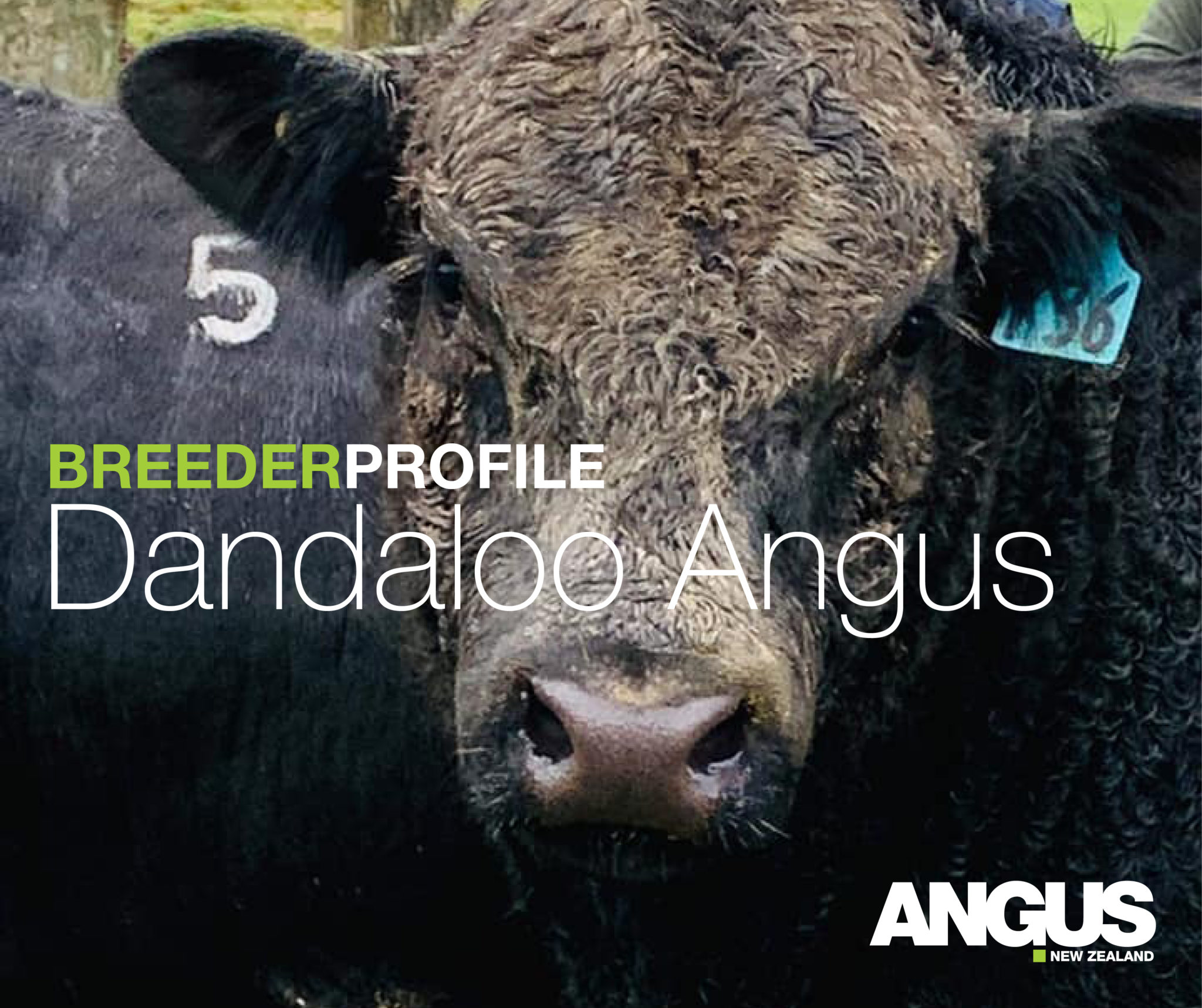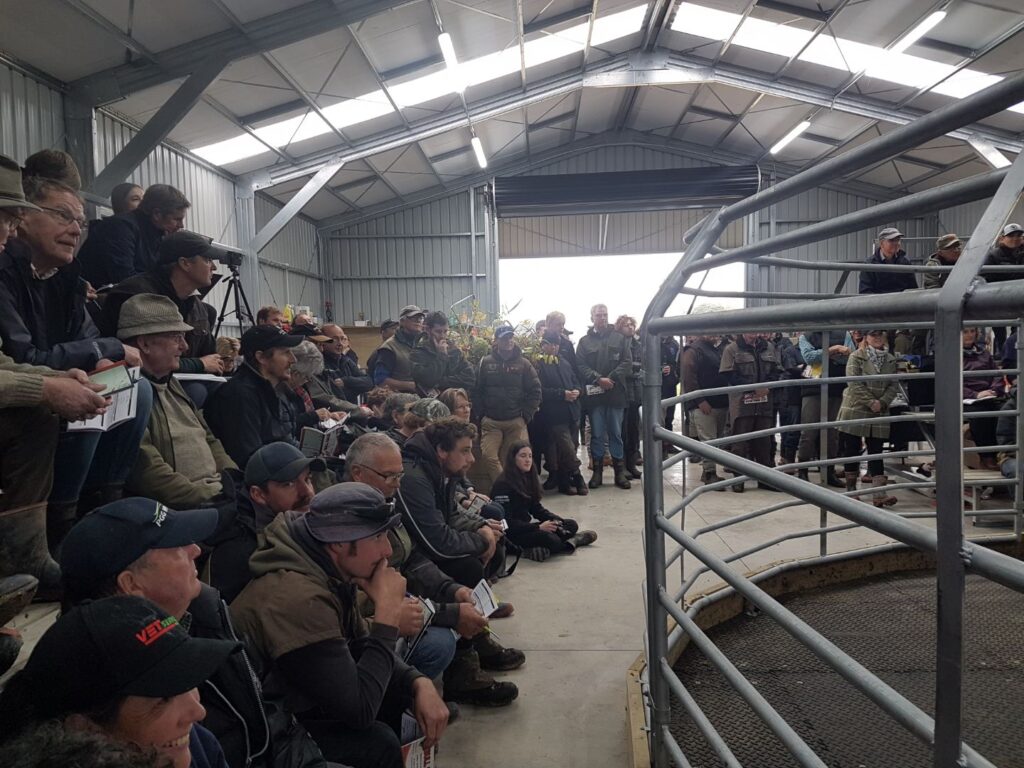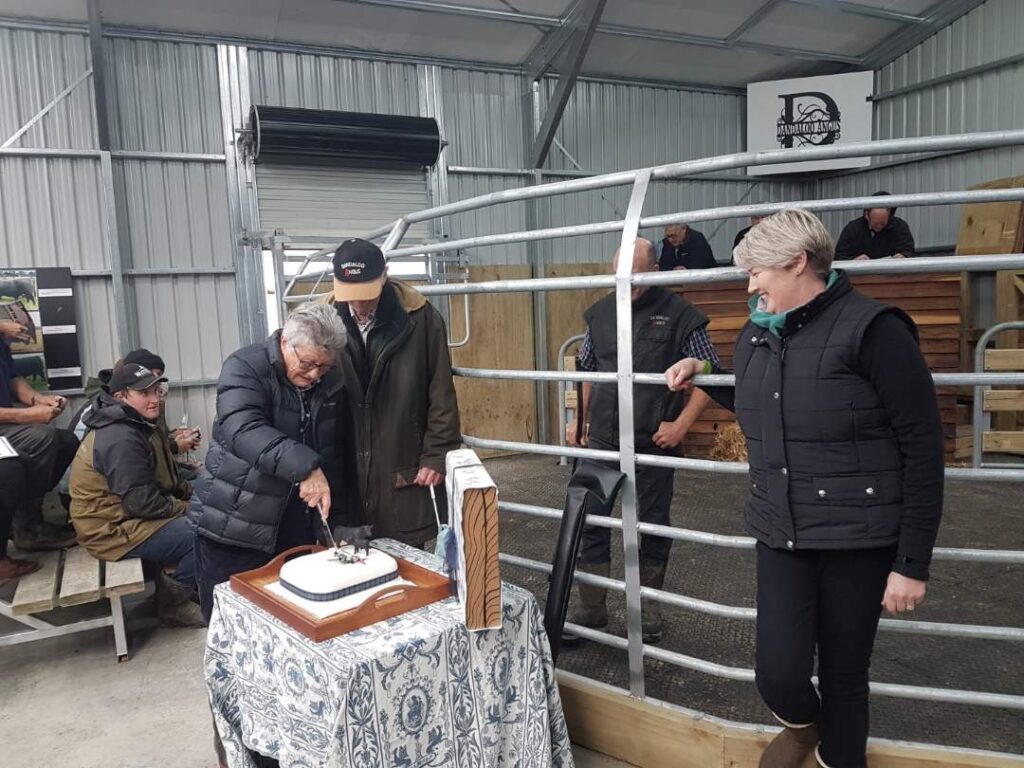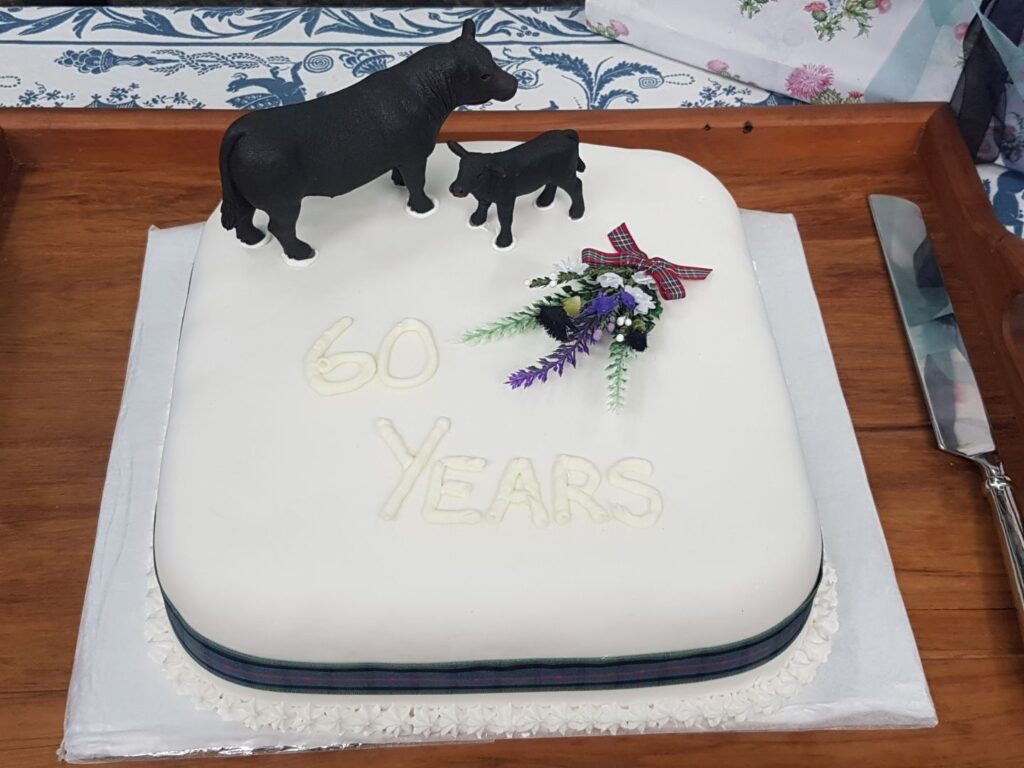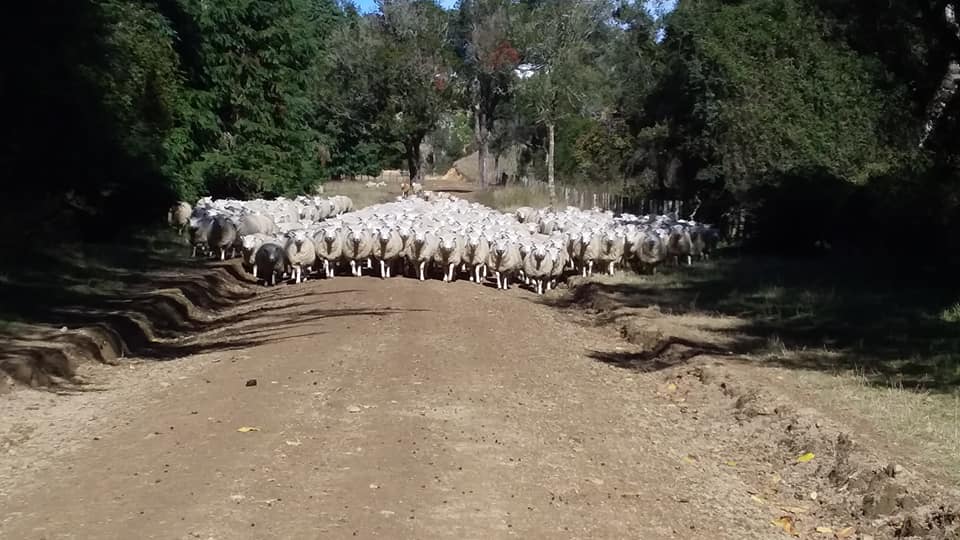
DANDALOO
ANGUS
FOR BETTER BALANCED BEEF
Breeder Profile:
Angus & Trish Thomson
Words by
Natalie Campbell
60 Years of Dandaloo Angus Stud
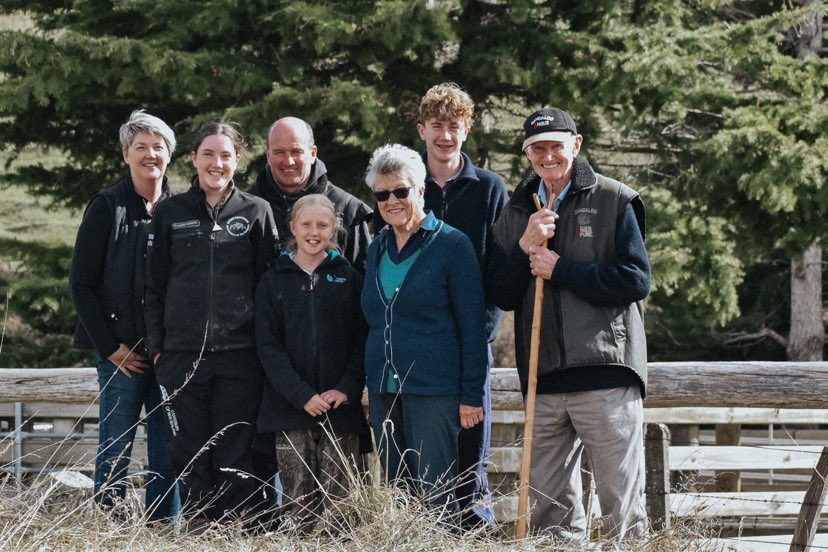
The only true flat country of the Dandaloo Angus Stud is home to the on-farm bull sale rostrum where the Thomson family have just celebrated 60 years of breeding Angus cattle.
The rest of the 420ha (effective) property is rolling to steeper hill country and stud principals Angus and Trish Thomson chuckle when they say the only flat area on the Wairarapa farm is home to the sale ring.
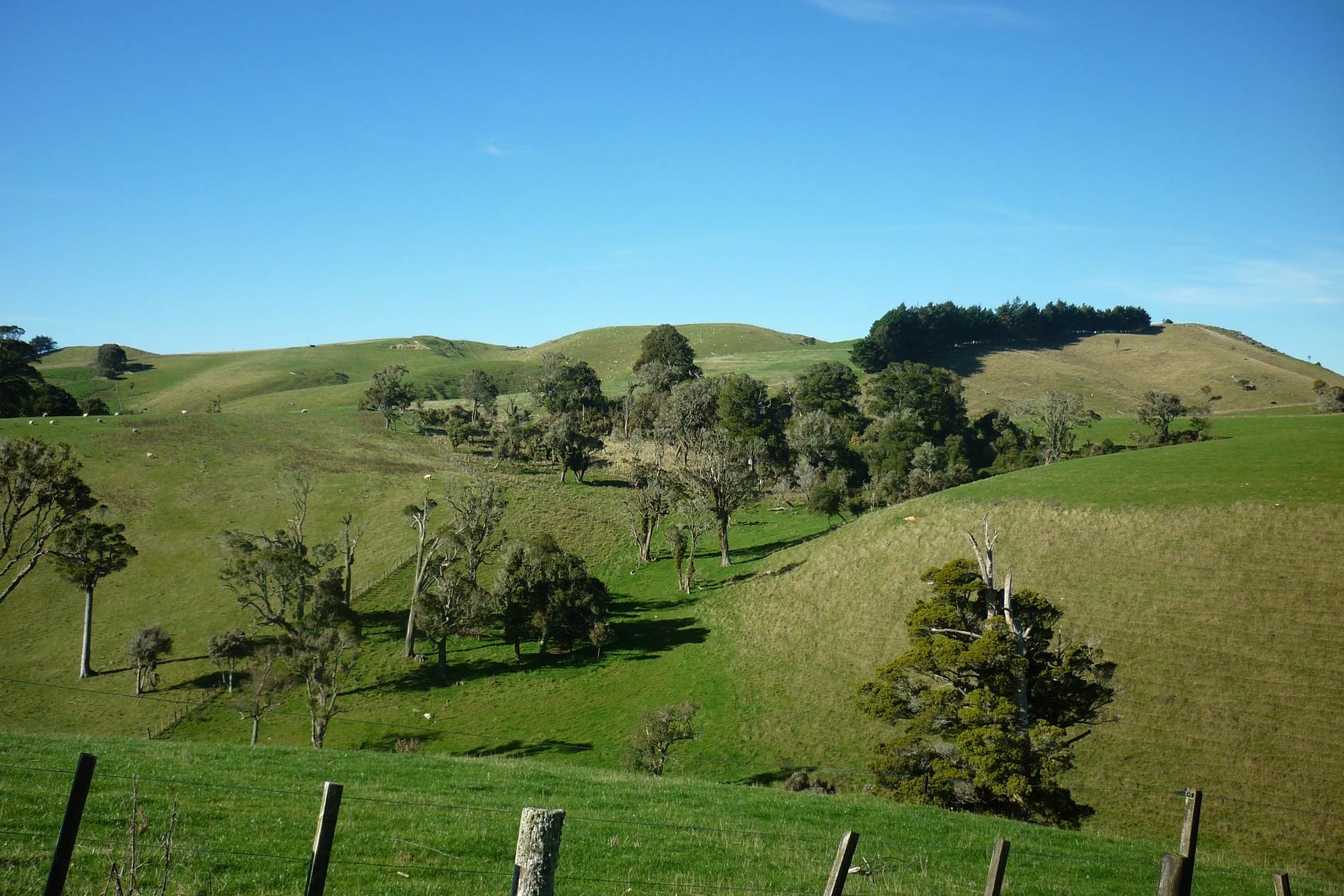
The stud was established by Angus’s parents David and Barbara in South Wairarapa with the purchase of three in-calf heifers from the Kahika Stud of the Nilsson family in Hawke’s Bay.
Angus says his father spent time working on studs in Australia and exhibiting cattle at the Sydney Royal Show and became passionate about the breed then.
The Dandaloo herd has moved twice since the first females were purchased and is now located at the top of the Maungaraki Ranges, 30kms south of Masterton with Trish and Angus taking over the business in 2008.
Angus notes that about 30 of the present dams have bloodlines going back to one of those first heifers.
David has often been quoted saying; “Women rule the world (he waits for a reaction)…. In the cattle business it’s all about female genetics and traits – especially temperament.”
Other founding female genetics were purchased from Cricklewood, Ngawaka and the Ellterton studs. In 1983 23 in-calf heifers from Kaharau were purchased and increased herd numbers.
To celebrate the 60-year milestone the family chose to mark the occasion in conjunction with the on-farm bull sale. A plated meal was served as well as an anniversary cake cut by David and Barbara with speeches. To top off the celebrations all bull purchasers were gifted a craft beer, whiskey or wine pack.
The 60th anniversary is not to be under-estimated and Angus admits that while he’s pretty busy at the moment, in a few months’ time he’ll no doubt look back on it with admiration.
“Coming together is the beginning. Keeping together is progress. Working together is success,” says the Thomsons.
This year’s sale was a strong result with all 34 bulls sold and a top price of $23,000.
“We were happy with that but would always like a bit more,” says Angus laughing.
The 200-cow herd is managed alongside 1300 Romney and Romney Texel cross ewes and about 300 replacement ewes on the property that rises to 550masl (as high as the peak of the Rimutakas – the iconic mountain range at the foot of the North Island).
Rainfall averages 1100mls and snow falls about four times a winter.
Meeting the needs of their hill country clients is at the forefront of the Dandaloo breeding objectives.
To do that the Thomsons have focussed on developing a herd of efficient cows suited to East Coast hill country.
Angus says to them this means a medium framed, well fleshed cow that recovers quickly after adverse climate conditions and conceives and rears a good calf.
“Often under difficult East Coast hill country conditions our cows are run in a commercial environment and used to prepare pasture for sheep.”
The Dandaloo breeding philosophy is to breed bulls of bone and substance that will sire productive, fertile females that, in turn, will leave progeny that appeal and perform in the commercial market.
“It’s always satisfying to see our clients getting good results in the market place,” says Angus.
The fact the Thomsons have a long standing and loyal bull buying clientele speaks volumes of the difference their breeding programme is having for their clients.
Angus says the majority of their bull-buyers are hill country commercial cattlemen from the South Wairarapa.
“We have very loyal clients. There’s about 30-40 of them and they come back each year. They are all local.”
When it comes to genetics that have influenced the Dandaloo herd significantly, Angus says there’s one particular sire that stands out – Basin Max 602 from Montana, a bull he first laid eyes on 15 years ago.
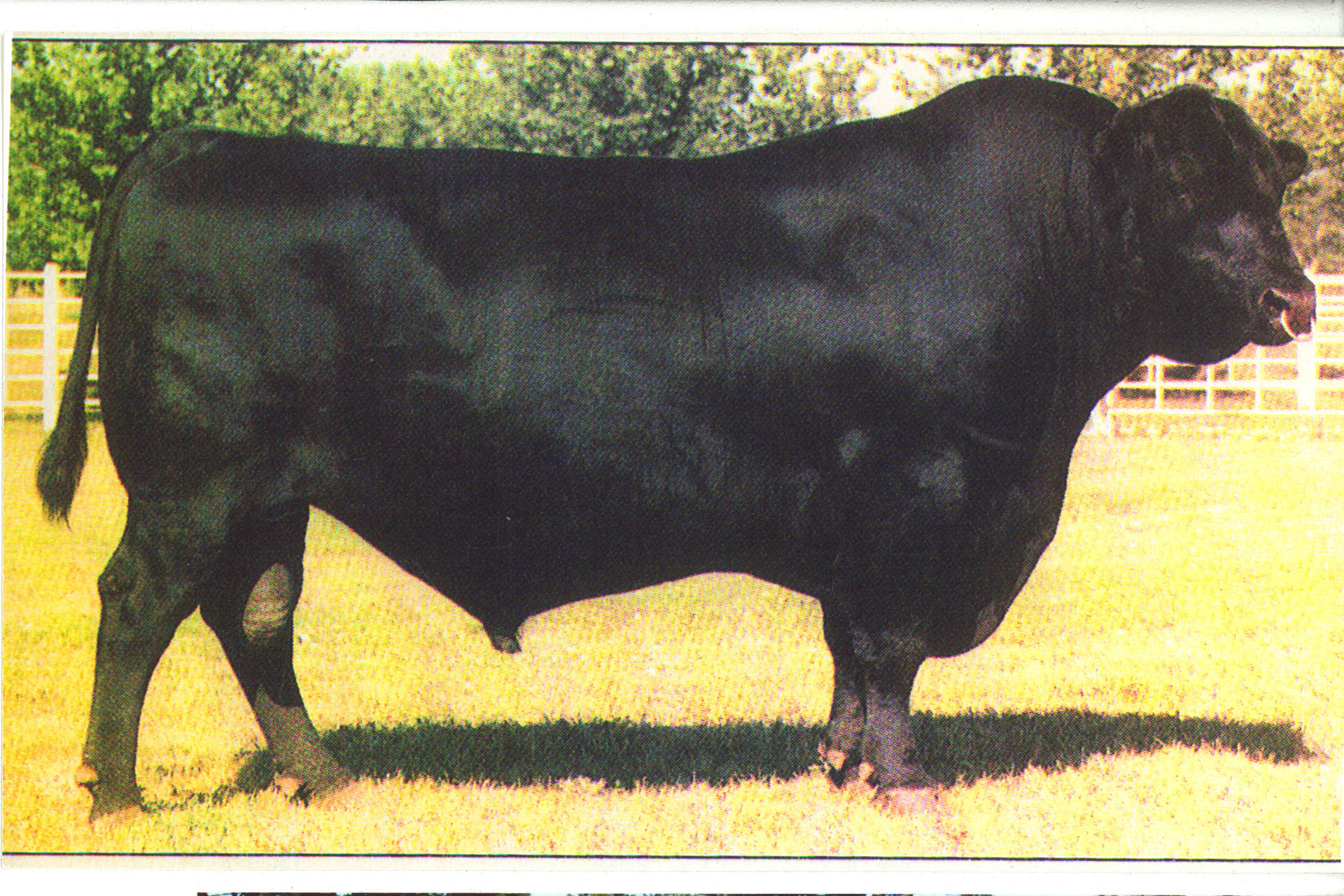
“I was up there and had seen at least 1000 bulls and then all of a sudden, bam I saw him.”
Angus says as a sire he was well boned and has a very meaty carcase. The Thomsons imported semen and used him in their AI programme.
AI is used on 40-50 cows most years and while Angus doesn’t do the work himself, he sees it as a mechanism to access genetics he wouldn’t normally be able to access.
“There was a bull that sold for $100,000 in Gisborne a few years ago and we’ve recently purchased some semen from him.”
“AI helps good genetics coming through and gives us access to those we might not be able to afford otherwise.”
In all but one of the past four years, AI has been used.
Like a lot of farmers marketing of the Dandaloo genetics is an area Angus says he and Trish would like to develop.
They advertise in newspapers and have a growing Facebook following; however, Angus says the best thing they’ve ever done is put their stud brand and name on the back of a stock truck.
“It goes exactly to the people we want to get to and provides better value than newspaper advertising.”
“It’s on the back of a Martinborough Transport truck. They do all our cartage for us, so I asked if we could put our branding on the back of the truck and they came back with a price and said yes.”

Despite not necessarily finding marketing easy the Thomsons have identified that digital marketing is going to play a bigger role in the future.
“We have a website and Facebook page and feel that’s going to become more important. People get more of their information using technology these days.”
TACE data and EBVs are used in selecting sires but only after a thorough eye appraisal for structural soundness and temperament.
Angus says data is then used to reinforce his phenotypical assessments.
“It’s about the cow or bull that’s in front of you. We look at the animals first and encourage our clients to do the same, then look at the figures and pedigree. If you see something you like in the paddock then go and look at the catalogue.”
When sourcing sires for herd use Angus says he also places emphasis on the female line.
“I like to select bulls from cows that have been around a long time – proven cows.”
“If there’s two bulls I like in the paddock, I check out the dam line in the pedigree then the EBVs follow.”
The Dandaloo Angus herd is fully performance recorded.
A Year At Dandaloo
Early winter and prior to calving the cows are at work cleaning up pasture ahead of the twin carrying ewes. As the cow’s approach calving, they will be either spread out in a calving area or grazed behind a wire. Angus says this decision is dependent on the season.
Once calving is underway, generally late August, the calves are tagged and weighed every day.
“Our calving date is early enough for up here,” says Angus.
Once calving is finished the cows and calves are run together before they’re sorted and grazed in their mating mobs.
Lambing starts in September and a typical lambing tally is 140% from approximately 1200 ewes. Between 200-300 ewe lambs are kept as replacements with all other ewe lambs and the ram lambs finished and supplied to Affco with a target weight of 17-20kgCW.
The bull joins the cows mid-November. Heifers are mated as yearlings and calving ease is a priority ahead of birth weights.
Following mating, about mid-January, the cows and calves are drafted off into bull and heifer calf mobs and the calves are treated with a 10 in 1 vaccine.
Weaning occurs in early to mid-April, and again it’s a date governed by the season. Following weaning the cows are put to work grooming pastures.
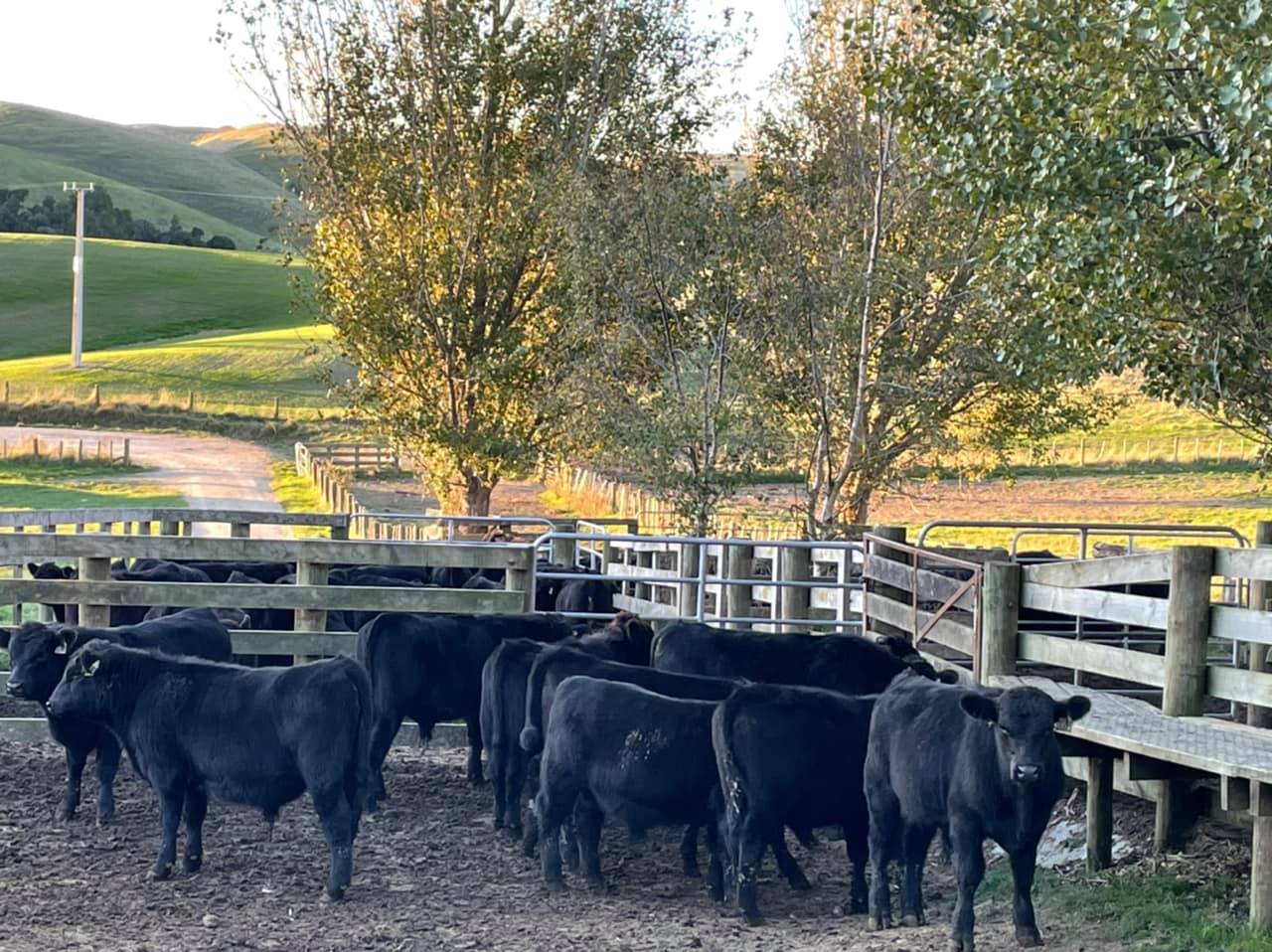
Angus says the goal is to wean calves in the high 200kgLWs or low 300kgLW but he said again the season has quite an influence on weaning weights.
“It’s all about what they have in front of them,” he says.
Once weaned the heifers and bull calves are run in their own mobs of generally about 100 head. Running them in these groups helps the Thomson’s selection process.
“Running them in mobs over winter and early spring we can tell who’s going to make the cut.”
The top line of heifers will go on to be herd replacements while the top bull calves will be grown on for the bull sale. The cull heifers and bulls are finished.
Angus is targeting finished weights of about 300kgCW at 16-20months old in the bulls and they are supplied to Affco while the cull heifers are supplied to AngusPure and are killed at Land Meats in Whanganui with a target weight of 240kgCW.
He says supplying the AngusPure programme gives him pride in the beef he’s producing.
“AngusPure is consistent and as it’s grass fed it has more flavour. I was in a Melbourne restaurant a few years ago and we ordered a grain fed steak and a grass-fed steak to compare and it was easy to see the difference – the grass-fed steak was superior.”
Throughout winter the cows receive little to no supplementary feed but the bulls and heifer calves will get some baleage or hay. If it’s a particularly challenging season the cows will get some hay.
The supplements are a mixture of brought in and made on farm feed. Which is about a 50:50 mix of baleage and hay.
Protecting Farm Water Ways and Developing The Property
There’s been plenty of farm development to keep Angus and Trish busy.
While the property has great natural water supplies from a bore and springs, new storage tanks have been installed to future proof that asset.
“We have a high cattle to sheep ratio so we need plenty of water. We’re lucky because we have very good natural water,” says Angus.
A pasture development programme of about 40ha annually has been undertaken incorporating kale and pasja crops followed by short rotation grasses and red clover.
The kale is sown by direct drill then cultivation for pasja occurs.
R+M have been a priority and in particular fencing and environmental work.
Angus says both are on-going for the family but last year they spent $65,000 on fencing; protecting waterways and native bush that will regenerate.
“We’ve fenced off the native bush because it’s satisfying and want to see it looked after. There’s Totara and other hard wood natives growing in there and some are quite old and well established.”
Angus said they’ve had a few different groups from Wellington through to visit the bush – cavers, lizard enthusiasts and some from the botanical gardens.
“We happy for people to visit, they just need to ask.”
They’ve also recently fenced off both sides of a water way with more to follow as well as riparian planting.
“We did just over a kilometre last year (both sides) and will plant it up in the future.”
Waterway and bush protection is on-going with more planned.
“We have another bush block and some big springs we’re going to fence – they run all year round and it’s the best bloody water I’ve ever tasted – I drink it straight from the spring,” says Angus.
Technology in use on farm includes a Gallagher TSI system which plugs into the weigh scales.
Angus says the easy-to-read screen is a huge plus as it displays all the information for the animal on the scales in front you.
“A bull walks on and up pops his parentage and all his weights. It stores the whole herd and brings up that individual animals’ NAIT tag and visual tag.”
Angus laughs when he says his children input the information in the yards because they can do it faster than him.
The information is stored and can then be easily transferred to the computer in the house and what’s needed can be readily provided to PBBs registry team for uploading to TACE (formerly known as Breedplan).
Angus says the children have grown up helping on the farm. Eldest son Hamish is 16, Maggie is 14 and Isla is 9.
Trish handles all the farm paperwork and by his own admission keeps Angus organised.
She also works off farm two days a week lecturing at UCOL in Masterton. She’s an early childhood teacher by trade and before having their family she was a senior Kindergarten teacher for the whole Wairarapa district.
Angus and Trish agree the opportunity to go farming will be available for their family, but that decision will be up to them – there’s no pressure or expectations of the children to do so.
The Thomsons are actively involved in their local community. Trish volunteers and supports the schools often and Angus has coached a local rugby team for eight years (until recently) and this past summer he coached daughter Maggie’s Touch Rugby team. He also sits on the board of a local trust.
When asked about what the future holds Angus’s reply was instant and simple.
Survival.
“Survival as farmers is our main goal under our current Government – we have to keep moving forward.”
To find out more Follow the Dandaloo Angus Stud on Facebook
or visit their website: https://dandaloostud.co.nz/

